Stay in the know on all smart updates of your favorite topics.
Participation in RESILIO

This is the second part of a 5-piece movie on RESILIO blue-green roofs. We meet an expert on participation from the Amsterdam University of Applied Sciences ánd a resident from a social housing association de Alliantie complex on which a RESILIO Smart Blue-Green Roof just has been realized. We asked ourselves during the whole lifespan of RESILIO: How can we make smart sustainable solutions a hot and urgent topic for our citizens?
#participatie #socialhousing #heatstress #verduurzaming #resilientcommunities #residentengagement #indischebuurt
Geef laptops aan de Cyberbank

Amsterdam krijgt de eerste Cyberbank van Nederland; een soort voedselbank voor laptops en digitale ondersteuning. 💻♻️
Heb jij een laptop of heeft jouw organisatie laptops die de Cyberbank een tweede leven kan geven? Vraag je werkgever oude laptops te doneren aan de Cyberbank en deel deze oproep binnen je netwerk!
Hoe meer laptops, hoe meer mensen er blij gemaakt kunnen worden.
#decyberbankzoektlaptops
Hoe het werkt?
➡️ Organisaties en particulieren doneren hun oude laptops.
➡️ Jongeren met een afstand tot de arbeidsmarkt knappen ze op.
➡️ Mensen met een Stadspas met groene stip kunnen tegen statiegeld van €20 euro aanspraak maken op een laptop. De eerste opgeknapte laptops worden begin 2022 verdeeld.
Informatie over de inzameling van gebruikte laptops en de eisen vind je op https://decyberbank.nl/
Can Amsterdam even better support growth of its startup ecosystem?

This post is the third and last in a series of articles about the startup ecosystem in Amsterdam Delta (Amsterdam metropolitan region). The first dealt with the dual challenge for start-ups to become socially and environmentally sustainable and to empower employees to be entrepreneurial through shared leadership. The second one was a review of the strengths and weaknesses of the Amsterdam startup ecosystem by the authors of the 2021 Global Startup Ecosystems Ranking.
Weaknesses and strengths
The 2021 Global Startup Ecosystem Report revealed several weaknesses in the Amsterdam startup ecosystem, which – I accentuate - should not overshadow the city’s position of Amsterdam as the world number 13 startup ecosystem. In terms of market reach, the overall score is satisfactory (7), but the Amsterdam Delta startups are primarily focused on global markets and score low on the local market. In the field of talent, the overall score is more than sufficient (7), due to the quality of technology students and graduates, but their number is inadequate, resulting in high vacancies and salary costs. Partly related to this, the growth potential (scalability) of the Amsterdam startup ecosystem is also insufficient, due to a limited reservoir of experienced entrepreneurs. Overall knowledge success is assessed as poor (1!) due to the unsatisfactory number of life science patents.
Amsterdam Policy plan 2019 - 2022
Most of the underlying data of the 2021 report is from 2019 – 2021, a time frame that coincides with the start of the new policy plan for startups in Amsterdam in the period 2019 - 2022. The inventory of challenges in this report mirrors several weaknesses mentioned above. Looking at the future, the report states: We have reached a point where growth of the local ecosystem does not have to mean that the local government wants to encourage as many companies in Amsterdam as possible but encourages activity that adds value to the city in new ways. In the coming years, we must also lay the foundations for a more inclusive society, in which the local startup and scaleup ecosystem also plays a role. A step towards inclusiveness means significantly increasing the business sector’s ambitions for social responsibility. In other words, a focus on quality in general that is aligned with at least the first challenge in the first post I referred to above.
How cities can support their startup ecosystem?
Below, I discuss highlights from the policy report 2019 - 2022 within a broader vision of possibilities for municipalities to support start- and scale-ups, partly based on an earlier edition of a The Global Startup Ecosystem Report.
Financial support
According to the 2021Global Startup Ecosystems Report, the funding of new businesses is not a big problem in Amsterdam Delta, also because of the generous tax facilities(!) in the Netherlands. However, investment relies heavily on local investors and governmental grants: 54% of the capital flowing into the ecosystem comes from domestic sources, 25% from the rest of Europe, and just 21% from the rest of the world.
The City of Amsterdam subsidized the Innovation Center for AI (ICAI) at Amsterdam Science Park, requiring that at least 20% of its revenues will be reserved for innovative SMEs and startups.
While funding is not an overriding problem, Amsterdam can improve its coordinating role in providing financial support, as for example Seoul has done by the creation of the Dream bank, a one-stop agency for all financial matters.
Growth of markets
The market position of Amsterdam start- and scaleups can be improved, especially in the home market, but also internationally. Besides, every new startup must start from scratch by creating a market. An agency called Amsterdam Trade and Innovate has commissioned trade developers to organize domestic and international activities that support promising companies in clusters such as technology, health, life sciences, and creative industry.
Expanding the reservoir of entrepreneurs
Amsterdam focuses on women and young people with a migration background, most of whom never received tech-related training. Initiatives such as House of Skills, Action Plan W&T, House of Digital offer a range of technology-based courses to make up for these shortcomings, alongside startup schools such as BSSA, Growth Tribe and The Talent Institute.
In December 2020, the City of Amsterdam announced it will invest yearly US$ 856,500 in RISE, the Female Hub Amsterdam. There is a high demand in sectors such as artificial intelligence, blockchain, robotics, life science and energy storage, while relatively many university students in technology seem to prefer media studies and gaming and the fintech market is almost satorized. Studying will become more attractive by combining study and jobs and affordable (co-)housing and childcare options, both of which are both are seriously lacking.
In addition, the ‘Warm Welcome’ program aims to attract ambitious tech talent from abroad. Unfortunately, the pandemic has significantly reduced the influx of potential talent from abroad while market opportunities for innovative tech startups and scaleups were improving.
Campuses
Innovative and research-oriented start-ups prefer the proximity of comparable small and medium-sized companies in campuses. They also prefer locations in mixed urban environments. A campus offers space for complementary companies, large and small, and facilities to collaborate, such as shared laboratory spaces. Amsterdam develops urban innovation districts through regional development and transformation. These areas that can accommodate rapid growth and opportunity for clustering ‘anchor companies’, leading (knowledge) institutions, startups, scaleups, incubators and accelerators. The main areas are: West Innovation Park, Amsterdam Sciencepark, Marineterrein , AMC-Amstel III and VU-Kenniskwartier/Zuidas.
Participation in the network of incubators and accelerators
Startups and scaleups need support. Incubators help companies to settle, accelerators help them to grow steadily. One of the best things any city can do is actively participation in these incubators and accelerators. They can become a one shop-stop for all prospective participants, providing virtually all the support start- and scaleups need. 31 of the 89 incubators and accelerators in the Netherlands, are active in the Amsterdam metropolitan area. A rich pallette of incubators and co-working spaces such as TQ, WeWork, Spaces, Startup Village, Rent24 and B.Amsterdam have been set up. Accelerators are Rockstart, Startupbootcamp, Fashion for Good, ACE and Collider.
Within an incubator or accelerator, the municipality can be primary responsible for legal matters, offering work- and living spaces (initially for free and later rented out at attractive rates), trade missions and procurement.
Internships
In some cities, startups can practice aspects of social and environmental sustainability in public administration. An example is the Startup in Residence program that started in Amsterdam and has now been spread over 20 other Dutch cities, regional governments, and ministries. The program is open to both Dutch and foreign entrepreneurs. Professional coaches provide intensive training and support. Workspace is available too. Under certain conditions, local, regional, and national governments become launching customers or partners. A report provides a detailed overview of the program in Amsterdam and its impact on the participants and the community.
Taking care of starters in general
Only a small but previously unknown part of all starters becomes a startup. Moreover, the number of starters outsizes that of startups and some can become valued companies too In the Netherlands, each year more than 100.000 starters are registered with the Chamber of Commerce.
Short evaluation Amsterdam policy plan 2019 - 12022
I doubt whether the current Amsterdam policy on start- and scaleups will result in a better ranking next year, also because in many cities startup ecologies are growing faster. Personally, I believe that consolidating a position in the top 20 is the best possible and still admirable result. This certainly applies if Amsterdam can achieve its ambitions in the field of qualitative rather than quantitative growth. Amsterdam wants to become an inclusive community and the first circular city in the world. The city wants that start- and scaleups becoming forerunners in reaching these objectives. I am partly disappointed in the content of the policy report 2019 - 2022 regarding this ambition. Indeed, becoming a more inclusive community is reflected in supporting the growth of the number female entrepreneurs. However, I looked in vain at policies encourage activity regarding developing start- and scaleups that add value to the city in new ways for instance contributing to the development of the circular economy. These businesses will make the difference in the future startup ecosystem.
I will regularly share ‘snapshots’ of the challenge of bringing socially and ecologically sustainable cities closer using technology if useful. These posts represent findings, updates, and additions to my e-book Humane cities. Always humane. Smart if helpful, chapter 4 in particular. The English version of this book can be downloaded for free below.
Barcelona and Madrid: Forerunners in e-governance

Barcelona is one of the oldest examples of a city that deploys technology as part of its government. Sensor networks have been producing an array of data on transport, energy usage, noise levels, irrigation, and many other topics without having much impact on the life of citizens or solving the underlying problems.
In 2015, Francesca Bria, chief technology, together with mayor Ada Colau started to reverse the smart city paradigm: Instead of starting from technology and extracting all the data we started aligning the tech agenda with the agenda of the city, she said.
One of the first challenges was using technology to increase ordinary citizen’s impact on policy. A group of civic-minded coders and cryptographers created a brand-new participatory platform, Decidem (which means We Decide in Catalan). For more information watch the video below.
Spain offers more inspiring examples. The city of Madrid has also created a participatory citizen platform, not for chance called Decide Madrid, which is in many respects comparable with Decidem, as this short video demonstrates.
The most important features of both platforms are:
Active participation in policy making
Citizens are stimulated to suggest ideas, debating them, and vote. In Barcelona, more than 40.000 citizens have suggested proposals, which form 70% of the agenda of the city administration. The most frequently mentioned concerns are affordable housing, clean energy, air quality and the public space.
The Municipal Action Plan of Barcelona includes almost 7,000 proposals from citizens. Decidem enables citizens to monitor the state of implementation of each of them to increase citizen’s engagement.
Debating
Decide Madrid and Decidem emphasize the value of being informed as starting point for deliberation. Citizens can start discussions on their own and participate in threaded discussions started by others.
As soon as citizens feel informed and have exchanged opinions voting can start. Both Decide Madrid as Decidemhave a space where citizens can make proposals and seeks support. Proposals that reach enough support are prepared for voting. These votes generally are advising the city council.
Policy preparation
Decide Madrid enables citizens amendment legislative texts. The public is allowed to commend any part of it and to suggest alternatives. This also might result in discussions and the suggestions are used to improve the formulations.
Data governance
Decidem and Decide Madrid are also data portals that show data that have been collected in the city, partly on citizens themselves. Decidem has the intention, because of its participation in the European project Decode to enable citizens to control the use of data of their own for specific purposes.
Hybrid solutions
As not every citizen has a computer or is skilled to use the Internet platforms, both cities combine virtual discussions and discussion in a physical space.
It is not only the traditional rivalry between Barcelona and Madrid that has inspired the development of two comparable systems, independently from each other. It is also the fact that the Spanish people had to fight for democracy until rather recently. Democratic institutions that have long existed in many other countries had to be reinvented, but with a 20th-century twist.
The community of Madrid has developed Decide Madrid together with CONSUL, a Madrid-based company. CONSUL enables cities to develop citizen participation on the Internet quickly and save. The package is very comprehensive. The software and its use are free. CONSUL can be adjusted by each organization to meet its own needs. As a result, Consul is in use in 130 cities and organizations in 33 countries (see the map above) and reaches out around 90 million citizens worldwide.
In contrast with e-Estonia, the topic of a former post, the footing of Decidem and Decide Madrid is enabling citizens to make their voice heard and to participate in decision-making. Both cities offer excellent examples of e-governance. e-Governance reflects the mutual communication between municipal authorities and citizens using digital tools to align decision making with the needs and wants of citizens. Instead, the intention of e-Estonia is to improve the efficiency of the operation of the state. Both aims are complementary.
I will regularly share ‘snapshots’ of the challenge of bringing socially and ecologically sustainable cities closer using technology if useful. These posts represent findings, updates, and additions to my e-book Humane cities. Always humane. Smart if helpful. The English version of this book can be downloaded for free below.
Transforming the food system through impact-driven ventures

A sustainable food system is critical to our social and planetary well-being.
New initiatives have a big role to play, and Metabolic's newest venture, Fresh Ventures Studio, is looking to help build promising companies to solve systemic challenges.
Fresh Ventures is a venture-building program and startup studio based in The Netherlands. They co-found companies with experienced professionals and entrepreneurs to address systemic challenges in the food system.
If you're an entrepreneur looking into building a venture that responds to the world's sustainability challenges, sign up with Fresh: https://www.freshventures.eu/
More about its establishment and purpose from this article.
LIVECAST: De sociale rekening van de energietransitie

Wie betaalt de rekening van de energietransitie eigenlijk? Nu komen duurzame subsidies nog vooral bij hoge inkomensgezinnen terecht en voelen gezinnen met een lager inkomen duurzaam beleid relatief veel harder in hun portemonnee.
In Amsterdam Zuidoost is de energietransitie al volop aan de gang: het warmtenet wordt uitgebreid en burgerinitiatieven voor bijvoorbeeld alternatief gas ontstaan. Maar tegelijkertijd blijft isolatie vaak achter, stijgen energierekeningen en zijn er bewoners die de informatie niet begrijpen of vertrouwen.
Sociale gevolgen van de energietransitie
In deze LIVECAST gaan we in gesprek over de sociale gevolgen van de energietransitie. Hoe maken we de energietransitie rechtvaardiger, zodat het voor iedereen voordelig is om mee te doen? Een gesprek over klimaat en ongelijkheid aan de hand van voorbeelden uit Amsterdam Zuidoost.
Note van ASC: Like als je vindt dat meer mensen dit moeten lezen. De populairste berichten lichten we uit in onze Weekly nieuwsbrief.
14 questions to guide entrepreneurs towards deep and lasting impact

To achieve a circular economy, innovation is key. One of the key ways to get here is through entrepreneurship. To be effective in this journey, entrepreneurs need to know how to navigate what creating a deep, transformational impact really means.
• How do we decide where to focus our attention?
• How do we design solutions and organizations that provide the best chances for success?
14 questions to maximize impact
Chis Monaghan, Co-Founder at Fresh Ventures Studio, a Metabolic spinoff, developed these 14 questions to serve as a simple checklist for anyone looking to maximize the impact of a particular initiative. Fresh Ventures is a venture-building program and startup studio based in The Netherlands.
Comenius Leadership Fellow grant to make AUAS students AI-ready

The Centre of Expertise Applied AI of the Amsterdam University of Applied Sciences (AUAS) has been awarded a Comenius Leadership Fellow grant of €500,000 for the AI4Students project. Over the next three years, the project headed by Professor of Responsible AI Nanda Piersma intends to use the Comenius grant to equip AUAS students for a future in which artificial intelligence (AI) will play an increasingly important role.
The assessment committee of the Netherlands Initiative for Education Research (NRO) selected the project from a total of 15 applications and praised AI4Students for its innovative character and the expected benefits for students, lecturers and the professional field. “Because of the social relevance of the topic, the committee is confident that the outcomes will be valuable to students and lecturers as well as the professional field.”
AI-ready upon graduation
AI4Students is a project that should have an impact in all faculties of the Amsterdam University of Applied Sciences. “We would like to ensure that all AUAS students are AI-ready by the time they graduate, not just with a general acquaintance with AI, but AI specifically geared to their field of study,” Piersma explains. “So it’s not about them studying with us first to become an accountant or physiotherapist, for example, and then having to take an additional training course as soon as they start their job. Instead, they should already be thinking with us about how AI is going to affect their job.”
The Comenius Leadership Fellow 2021 grant will enable Piersma to start fulfilling that ambition over the next three years. “What we want to do is start performing an AI impact scan for 9 degree programmes,” Piersma explains. “In what way is artificial intelligence going to impact a professional field? How will this affect what professionals need to be able to do, and what does that mean for the degree programme itself?”
Metropolitan Mobility Podcast!

Chris Bruntlett (Dutch Cycling Embassy) and Geert Kloppenburg are looking back at the Celebrating Cycling Cities event and our interviews with mobility experts from all over the world! Listen to the best practices and who we would like to speak next: https://bit.ly/mobilitypod
De extreem ambitieuze missie van Amsterdam Smart City: Bruto Menselijk Geluk voor 2030

Onze inzending voor ‘Missie Nederland’ van de Volkskrant (wat kan eigenlijk niet, maar wil je toch voor elkaar krijgen), oftewel een “Moonshot”, is het creëren van Bruto Nationaal Geluk met digitale sociale innovatie. In 9 punten de missie die we samen met Future City Foundation, het G40 Stedennetwerk, BTG Branchevereniging ICT en Telecommunicatie Grootgebruikers hebben ingestuurd.
Om dit te bereiken, moeten we zorgen dat íedereen kan meedoen in onze maatschappij, onze democratie. Ook de groep mensen die we nu niet horen. Met digitale technieken maken we nieuwe verbindingen mogelijk. Zodat je mee kan doen, bij kan dragen, ook als je de deur niet uit kunt, verbaal minder sterk bent of amper tijd hebt. Zo kan iedereen bijdragen aan het eigen geluk én aan dat van een ander.
In 2030 ...
… is geen enkele Nederlander meer digibeet, in plaats daarvan is elke Nederlander digitaal vaardig.
… heeft elke inwoner van Nederland toegang tot hoogwaardig internet. Dat betekent dat elk huis wordt aangesloten op snel vast en mobiel internet en elk huishouden in staat is om apparaten te kopen waarmee toegang mogelijk is. Een goede laptop is net zo belangrijk als een goede koelkast.
… wordt het internet op een nieuwe manier gebruikt. Toepassingen (software en
hardware) worden vanuit de gebruikers gemaakt. Met als uitgangspunt dat iedereen ze kan gebruiken. Programma’s en de daarvoor benodigde algoritmen worden zo geschreven dat ze ten dienste staan van de samenleving en niet van het bigtech-bedrijfsleven.
… heeft elke inwoner van Nederland een ‘self-sovereign-identity’ waarmee ze vrij, binnen de context van hun eigen grenzen, digitaal kunnen opereren en acteren.
… is nieuwe technologie ontwikkeld die de inwoners en bedrijven de kans mee te
denken en beslissen over en mee te ontwikkelen en handelen aan welzijn regio’s,
steden en dorpen.
… hebben alle Nederlandse politici verstand van digitalisering en technologisering.
… is het Nederlandse bedrijfsleven leidend in de ontwikkeling van deze oplossingen.
… zorgt dit alles voor meer welzijn en niet alleen voor meer welvaart.
… is het internet weer van ons.
Laat ons weten wat je ervan vindt in de comments. Lees ook de hele moonshot.
Op zoek: duurzame binding met je buurt
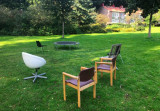
Interview met onderzoeker Anneke Treffers (HvA) over het belang van ‘buurtdragers’ om de binding met de buurt te versterken. Eindpublicatie toont resultaten van onderzoek naar de Couperusbuurt, Amsterdam Nieuw-West.
De Couperusbuurt: een multicultureel stadsdeel in Amsterdam Nieuw-West waar jong en oud samenkomen, maar ook kunnen botsen in opvattingen over wat hun buurt zowel prettig als onprettig maakt. De Hogeschool van Amsterdam (HvA) deed binnen project Ontwikkelbuurten onderzoek naar het belang van ruimtelijke structuren, plekken en programma’s die de binding van bewoners met hun buurt duurzaam kunnen versterken. Ofwel: ‘buurtdragers’. Onderzoekers Ivan Nio, Anneke Treffers en lector Bouwtransformatie Frank Suurenbroek presenteren na ruim twee jaar onderzoek de bevindingen.
De Nederlandstalige muziek van Café Content nabij de Couperusbuurt is eindelijk weer te horen nu de terrassen na lockdown open zijn. Vooral bewoners van het eerste uur komen hier regelmatig samen en dat is tekenend voor de buurt. Het is een voorbeeld van een ‘buurtdrager’ die samenhang en herkenbaarheid biedt, de leefbaarheid versterkt en de buurtbetrokkenheid van bewoners vergroot. Denk ook aan parkjes, hoven, portieken, winkelstrips en andere voorzieningen en faciliteiten in de nabijheid van de eigen woning.
Stedelijke vernieuwing in de Couperusbuurt
Maar niet elke buurtdrager is een voorziening voor iedereen. De Couperusbuurt kenmerkt zich als divers: jong en oud, multicultureel; maar de omgang met de verschillende groepen is laag. Daarnaast kent de buurt ook hardnekkige sociale problemen, waaronder een combinatie van een laag opleidingsniveau, een laag inkomen en een hoge werkloosheid. De veelal portiekwoningen, herkenbaar aan de typerende hovenstructuur van deze na-oorlogse wijk, zijn er erg klein, als gevolg van versnelde bouw na de Tweede Wereldoorlog. Nu anno 2021 wonen in deze kleine woningen een diversiteit aan bewoners en dat levert spanningen op.
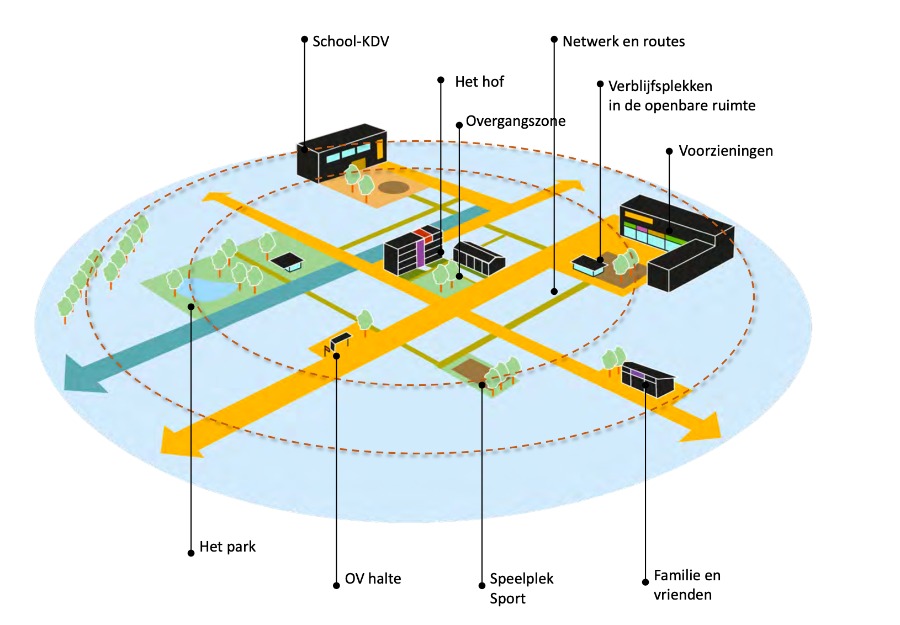
Voorbeelden van buurtdragers.
Maar er is hoop: de Couperusbuurt verwacht stedelijke vernieuwing en staat voor een nieuwe opgave de binding met de buurt en bewoners te versterken. ‘Dan is het nodig om de buurt in te gaan, te ervaren en de bewoners te spreken’, vertelt onderzoekster Treffers. ‘Niet iedereen staat te springen om vernieuwing. Wanneer je een goed overzicht hebt van hoe de buurt individueel beleefd wordt in relatie tot al bestaande buurtdragers, dan kun je pas gaan nadenken over fysieke ingrepen en investeringen die de leefbaarheid en de betrokkenheid bij de buurt kunnen verbeteren.’
Angst bij ouderen
Vooral bij ouderen heerst de angst dat het ‘dorpse gevoel’ door mogelijke ingrepen zou verdwijnen, vertelt Treffers. ‘Ze maken zich druk om de dagelijkse problematiek als grote hopen afval, geluidsoverlast en veiligheid; er zijn hangjongeren en spanningen tussen buren onderling. Maar ook nieuwe bewoners kennen een eigen soort ‘ongeduld’, meer gericht op de toekomst. Kort door de bocht gezegd verwelkomen zij zo snel mogelijk een Starbucks met latte macchiato's.’ En ook door observaties hoe mensen hun woonomgeving gebruiken, komt veel aan het licht: ‘We zien grote stenen pleinen zonder enkele functie, geen kind dat daar speelt. Net als tuinstoelen in het park door een gemis aan bankjes. Zijn die er wel, dan hebben die vaak geen rugleuning; wat moeten ouderen daarmee?’
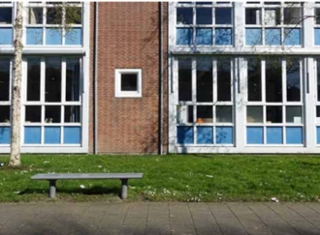
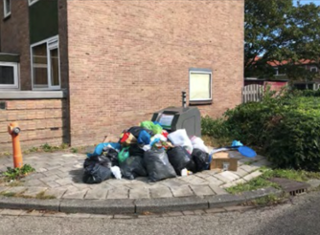
Voorbeelden van dagelijkse problematiek.
Van persoonlijke kaarten naar kansenkaart
De interviews en observaties omtrent bestaande buurtdragers zijn per doelgroep vertaald naar persoonlijke kaarten als een mindmap van de buurt, met daarop gevisualiseerd: routes, locatie van vrienden en familie, positieve en negatieve plekken, dagelijkse voorzieningen en horeca en recreatie. Treffers: ‘Wanneer je die kaarten over elkaar heen legt, zie je al snel de overlappende pijnpunten (vuil, geluidsoverlast, verstening), evenals de plekken met potentie. Met name de Couperusstraat biedt kansen, die loopt dwars door de buurt en kan als drager van de buurt gaan functioneren.’
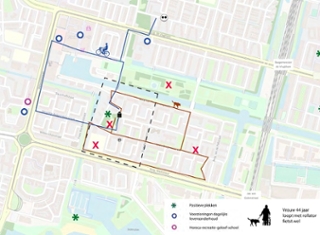
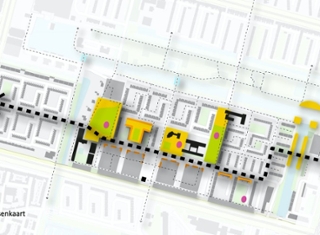
Persoonlijke kaart en kansenkaart - verbinding met de Couperusstraat.
In de eindpublicatie staan aanbevelingen voor gemeente en woningbouwcorporaties hoe de Couperusstraat bestaande en nieuwe buurtdragers aan elkaar kan verbinden. Zo kunnen alle groepen elkaar sneller kruisen, stelt Treffers. ‘Sociale cohesie in de buurt is misschien te hoog gegrepen, maar we kunnen wel publieke familiariteit realiseren. Wat dat is? We zagen iedere dag om 19.00 uur een aantal vrouwen van Turkse komaf op hetzelfde bankje in het park. Elke dag, op hetzelfde moment, kwam een man van in de 70 zijn hond daar uitlaten en maakte een kort praatje. Twee werelden die elkaar doorgaans niet snel ontmoeten in de Couperusbuurt. Die kortstondige ontmoetingen zonder verdere verplichtingen (publieke familiariteit) zorgen voor meer verbinding; zowel sociaal als fysiek.’
LEES DE EINDPUBLICATIE: BUURTDRAGERS IN DE COUPERUSBUURT
Meer informatie
Het project is de eerste verkenning in een langlopend onderzoek naar buurtdragers. Het vormt een waardevolle input voor de planvorming in de ontwikkelbuurten. Het onderzoek is vooral ook een middel om in nadere dialoog met gemeente en corporaties te verkennen naar wat voor soort buurtdragers we eigenlijk op zoek zijn. En waar zouden gemeente en corporaties maar ook andere partijen in moeten investeren in de buurt
Kijk voor meer informatie: projecten Buurtdragers en Ontwikkelbuurten.
ONLINE LIVECAST (WATCH NOW): Design from Inclusion -Products & Services

In earlier episodes of Designing Cities for All, we have seen that design is everywhere and everything around us is designed. We have also seen that there are flaws in these designs, because what we tend to do in this world is design for the middle and forget about the margins. Wouldn’t we create and build stronger structures for everyone, when we design for the people who are actually living with the failures of our designed products, spaces, and systems?
Podcast: Founder of Pakhuis de Zwijger on shaping cities together

In this episode Annick van Rinsum interviews Egbert Fransen: the founder and director of Pakhuis de Zwijger. He set up an unique regional, national and international podium which focuses on bringing people together who want to realise programs that contribute to a more sustainable, fair and future proof society.
Egbert Fransen: “It becomes more interesting if you bring people from different domains and different backgrounds together. My belief is very strong: creation and innovation take place in those places where you have heterogeneous groups of people. It is precisely not being equal, not thinking the same, that brings along innovation."
In these 56 minutes they share stories on:
• His entrepreneurial heart and motives
• The history and development of Pakhuis de Zwijger
• The recent rebranding and his plans for the upcoming 15th anniversary
Podcast #100: Egbert Fransen on shaping cities for everyone, by everyone (in Dutch)
How Strandeiland IJburg democratically develops in a green, social and sustainable island

Strandeiland is the newest artificial island in the IJburg archipelago in the IJmeer, on the east side of Amsterdam. The island is currently being constructed. With 8,000 homes, Strandeiland is one of the largest future urban districts in Amsterdam.
Involving citizens in urban development processes
How can citizens gain more control and ownership in the development of urban areas? To make the process of shaping the development plans of Strandeiland more democratic, the DemoS project was launched in October 2018. DemoS – democratic Beach Island – is part of the Participation Plan for this area and has been running for two years.
The Strandeiland project leader, municipal innovation team (CTO), the local municipality (Stadsdeel), three IJburg residents, researchers, and students of MSc MADE participated in the living lab project DemoS from 2018 -2020.
The aim of the participation trajectory was threefold:
- To set up a novel way of collaboration between civil servants and citizens around the participation processes of the design and development of Strandeiland.
- To share the gained insights transparently to inspire other citizens and civil servants.
- To grow a community of potential future Strandeilanders.
The participation team was loosely established on the principles of a living lab with the innovative focus on making city-making processes more inclusive and democratic. This is the first time in Amsterdam that civil servants and citizens work together in this formal agreement whereby citizens are engaged in creating the participatory processes. Continue reading about the results >>
NEW EUROPEAN BAUHAUS PARTNERSHIP FOCUSES ON A SUSTAINABLE FUTURE

The Amsterdam University of Applied Sciences (AUAS) has become an official partner of the European Commission's New European Bauhaus (NEB) initiative, which aims to transform the European Commission's sustainability agenda into real solutions that contribute to a sustainable and inclusive society. This partnership is coordinated via the AUAS’s Centre of Expertise for Creative Innovation (CoECI), a collaboration between four Amsterdam-based higher education institutions that is headed by AUAS. By participating in this initiative, AUAS and CoECI will focus on helping to create a sustainable and inclusive society through creative innovations with a broad network of partners.
New European Bauhaus stems from the Horizon 2020-funded European Green Deal, the latter of which aims to accelerate Europe's recovery from the coronavirus crisis by turning green challenges into innovation opportunities. Within the Green Deal, AUAS is already working on various project proposals with international partners that aim to help create a climate-neutral Europe by 2050 via our collaborative applied research. These EU initiatives align well with our new 3D strategy at the Amsterdam University of Applied Sciences, which prioritises sustainability as one of the three key domains for our institution in the years ahead, alongside diversity & inclusion, and digitalisation.
Beautiful, sustainable, together
Via the motto ‘beautiful, sustainable, together’, AUAS partners with New European Bauhaus New European Bauhaus (NEB) draws inspiration from Bauhaus movement 100 years ago and the belief that design can be a force for societal progress. To quote the project: “We want to create a design movement integrating three dimensions: sustainability (including circularity), quality of experience (including aesthetics) and inclusion (including affordability). Showing that creativity is in finding affordable, inclusive and attractive solutions for our climate challenges.”
The interdisciplinary nature of the initiative presents an excellent opportunity for the entire AUAS, and the creative sector in particular, to participate and help shape the future. CoECI supports this plan and, together with its network of partners both inside and outside the AUAS, will use its imagination and develop innovative concepts that contribute to the sustainable transition.
Activities
In the coming months, CoECI will join other partners in the Netherlands and Europe to discuss ideas for a sustainable future and how the creative sector can contribute to it. It will also review how faculties across the AUAS can collaborate on this great challenge from their own areas of expertise: from social questions and technical innovations to design perspectives.
CoECI brings together creative businesses, citizens, science and education in the Netherlands and Europe, to collectively create proposals and ideas for a sustainable Europe. The NEB initiative is now in the 'Design phase' and will kick off the 'Deliver phase' in September 2021. The AUAS hopes to be selected for this, which would see it set up and implement collaborative pilot projects. This will be followed by the 'Disseminate phase'. More information, including about the activities, will soon be available on the CoECI website (currently only available in Dutch).
Contact
Mareile Zuber, project developer at CoECI and responsible for the European partnership, is the contact person for questions/remarks/ideas and proposals regarding New European Bauhaus. You can reach her directly via m.a.zuber@hva.nl.
In addition to coordinating activities for New European Bauhaus, Mareile will focus on building bridges between CoECI/AUAS and other European consortia. This could include, for example, applications to European financing programmes such as Horizon Europe, Creative Europe and Digital Europe.
About the Centre of Expertise for Creative Innovation
The Centre of Expertise for Creative Innovation (CoECI) is the national knowledge and innovation network for the creative industry. CoECI uses art, media, technology and design to create a sustainable and inclusive urban society. These activities contribute to partnerships, both commercial and non-profit, between education and the professional field. In this way, CoECI connects research and talent with companies, social organisations and communities.
CoECI is a partnership coordinated by the Amsterdam Universities of Applied Sciences with three other institutions: the Amsterdamse Hogeschool voor de Kunsten (AHK) and Hogeschool Inholland (founding partners); as well as the Gerrit Rietveld Academy, which joined the collective in 2019. This collaboration was originally launched under the name Amsterdam Creative Industries Network (ACIN). CoECI covers the entire chain of artistic innovation: from experimental research to concrete interventions.
More information about New European Bauhaus is available via the website of the European Commission.
Metropolitan Mobility Podcast with Karen Vancluysen (Polis Network)
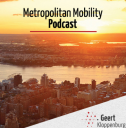
How can local governments deal with (technological) innovations? Listen to the #podcast with Karen Vancluysen of POLIS Network: https://bit.ly/mobilitypod
Effectief groen voor klimaatadaptatie in de stad
De HvA start onderzoek naar concrete handvatten voor klimaatbestendig en verkoelend stedelijk groen
Een groene stad is niet automatisch een klimaatbestendige stad. Groen is wel de meest effectieve maatregel tegen hittestress en kan bijdragen aan waterbestendigheid. Mits de inrichting hierop is ontworpen. Samen met Wageningen University & Research (WUR) en ontwerpbureau Niek Roozen onderzoekt de Hogeschool van Amsterdam (HvA) hoe een groene straatinrichting het meest effectief is voor verkoeling in verschillende wijktypen.
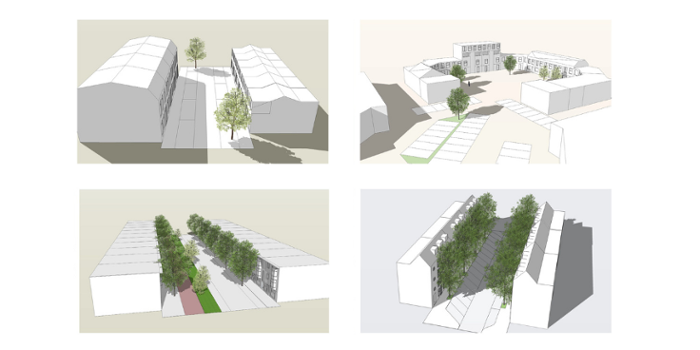
Een belangrijk praktisch aspect van het onderzoek is het waterverbruik van groen voor koeling, in samenhang met de opbouw van de bodem en de benodigde buffercapaciteit. Maar een duidelijk stappenplan hiervoor mist, stelt Jeroen Kluck, lector Water in en om de stad. ‘We krijgen vaak vragen over welk type groen het beste is tegen en bij klimaatverandering. Dit project helpt daar antwoord op te geven. Wij ontwikkelen concrete handvatten voor ontwerp, aanleg, inrichting en beheer van klimaatbestendig en verkoelend stedelijk groen.’
Vier wijktypen onder de loep
Voor verschillende soorten en ontwerpen van straatgroen onderzoeken wij enerzijds de verkoelende werking en anderzijds de kwetsbaarheid tegen verdroging. Daarbij richten we ons op vier karakteristieke en veel voorkomende wijktypen: het stedelijk bouwblok, de bloemkoolwijk, de volkswijk en een verbindingsweg. Ieder type heeft specifieke fysieke kenmerken zoals bouwhoogte, breedte van de straat en vorm van groene inrichting, welke bepalend zijn voor de mogelijkheden en effectiviteit van een nieuwe groene inrichting. De inzichten verwerken we in praktijkrichtlijnen en sjablonen voor deze wijktypen. Daarnaast werken we aan een nieuwe bomentabel waarin klimaatbestendigheid van typen bomen is verwerkt.
'Als we steden klimaatbestendiger willen inrichten willen we ook weten welk type groen het beste bijdraagt en het beste bestand is tegen die klimaatveranderingen. Super om dit samen met de mensen met groene vingers te onderzoeken' — Jeroen Kluck, lector Water in en om de stad
Interdisciplinaire samenwerking
Het project is een samenwerking tussen de groene sector, ontwerpers, landschapsarchitecten, stadsklimatologen en beheerders van het stedelijk groen. Het project is een mooie aanvulling op het onderzoeksportfolio van het HvA-lectoraat Water in en om de stad en met name de onderzoeken naar het klimaatbestendig inrichten van de stad, het hittebestendig inrichten van de buitenruimte, hittemetingen in de stad en ook het gebruik van wijktypen als basis om klimaatrisico’s en maatregelen te structureren.
Meer informatie?
Houd de projectpagina van 'Effectief groen voor klimaatadaptatie in de stad' in de gaten voor alle ontwikkelingen.
New podcast out !
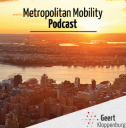
De Gouden Piramide ging in 2016 naar een bijzondere plek voor jonge mensen: Xenia Huis met een Hart Hospice en Logeerhuis Leiden. Luister naar het indrukwekkende verhaal van oprichtster Jacqueline Bouts: https://bit.ly/mobilitypod
'Pathways of hope' in onze publieke ruimte
Haastig zijn afgelopen jaar interventies in de publieke ruimte ontwikkeld en toegepast om de verspreiding van Covid-19 tegen te gaan. Hoe kunnen deze tijdelijke maatregelen in de openbare ruimte de structurele veerkracht van de buurt versterken?
Covid-19 maakte duidelijk hoe belangrijk onze gedeelde publieke ruimte is. Haastig werden afgelopen jaar interventies in de publieke ruimte ontwikkeld en toegepast om de verspreiding van Covid-19 tegen te gaan. Met stickers, hekken, geverfde cirkels, verkeersborden en digitale apps waarop op afstand de drukte in de stad af te lezen valt werd geprobeerd om stadsbewoners te verleiden tot social distancing. Al snel werden deze preventieve maatregelen vergezeld van nieuwe praktijken. Parkeerplaatsen boden tijdelijk ruimte aan groen en houten vlonders waarop de binnenstedelijke horeca en winkels hun werk in de buitenlucht konden voortzetten.
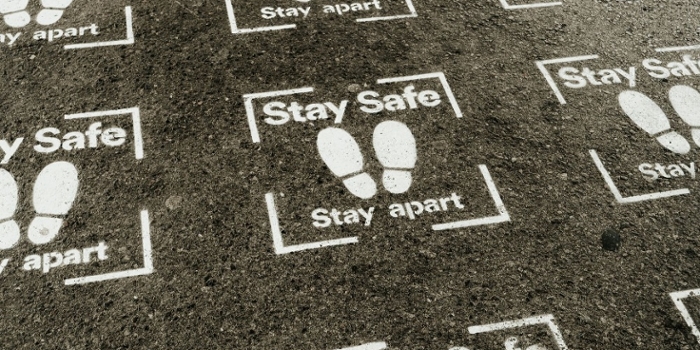
Foto: Ethan Wilkinson
Frank Suurenbroek, lector Bouwtransformatie van Centre of Expertise Urban Technology, en Martijn de Waal, lector Civic Interaction Design van Faculteit Digitale Media & Creatieve Industrie, over hun project 'Covid-19: Van preventie naar veerkracht'. Dit artikel is eerder gepubliceerd in HvA-magazine 'Bewogen Stad: Leren in crisistijd'.
Daarnaast toonden activiteiten die normaal achter gesloten deuren plaatsvinden zich plots in de buitenruimte. Gebruikers van shisha-lounges nestelden zich op stoeltjes voor de deur, sportscholen gingen lesgeven in de open lucht. Ook ontsproten er nieuwe sociale initiatieven zoals huiswerkklasjes in buurtcentra. Covid-19 leidde zo ook tot een experiment in het gebruik en de betekenis van onze gedeelde publieke ruimtes.
Van preventie naar veerkracht?
We weten echter nog weinig over de variëteit aan preventieve interventies in de publieke ruimte, hun werking en vooral ook de manier waarop die tijdelijke maatregelen ook de structurele veerkracht in buurten kunnen versterken. Afgelopen september kregen we een ZonMW-subsidie toegekend om dit te onderzoeken: Hoe kunnen ontwerpinterventies voor de 1,5 meter-samenleving in de publieke ruimte op buurtniveau ook bijdragen aan het versterken van maatschappelijke en ecologische veerkracht? Veerkracht gaat hierbij over de kwaliteit die de leefomgeving nu biedt, alsmede over de capaciteit in de omgang met de meer structurele sociale en ecologische uitdagingen van onze steden.
Delen gedurende de uitvoering
Covid-19 vraagt ook om snel handelen. Een centrale rol in ons project speelt de Community of Practice. Vijf gemeenten, twee woningbouwcorporaties, het PBL, ontwerpbureau UNStudio, social engineeringbureau The Beach, WandelNet en Pakhuis de Zwijger alsmede meerdere specialisten vanuit de HvA hebben zich in dit project verenigd. Covid-19 stopt bovendien uiteraard niet bij de landsgrenzen. Naast de Nederlandse partners heeft zich ook een kring van internationale kennisinstellingen aan het project verbonden: Harvard in de VS, The Bartlett School in Londen, University of Sydney en in Italië het netwerk City Space Architecture.
Preventieve ingrepen begrijpen
In de wetenschappelijke literatuur rondom veerkracht valt het handelen in crises uiteen in resisting (weerstand bieden), adapting (aanpassen), restoring (herstellen) en transforming.

Onderscheid in vier soorten handelingen in crisistijd
De preventieve maatregelen rondom Covid-19 passen overwegend in de categorieën resisting en adapting. Het gaat daarbij om tijdelijke oplossingen voor de problemen die nu spelen. Denk aan het plaatsen van hekken, het tijdelijk gebruik maken van parkeerplaatsen voor horeca en andere functies die niet langer binnen kunnen functioneren. Tegelijkertijd bieden deze ingrepen mogelijk ook de potentie voor meer transformatieve keuzes.
Zo zien we een aantal steden (Parijs, Milaan, New York) de crisis aangrijpen om een al langer levende mondiale visie in wording te versnellen om steden leefbaarder en inclusiever te maken. Deze visie raakt aan abstractere en meer toekomstgerichte perspectieven van veerkracht. Wat echter ontbreekt is inzicht hoe de huidige preventieve ingrepen ook de kansen en potentie van meer structurele transities van de stad kunnen bewerkstelligen.
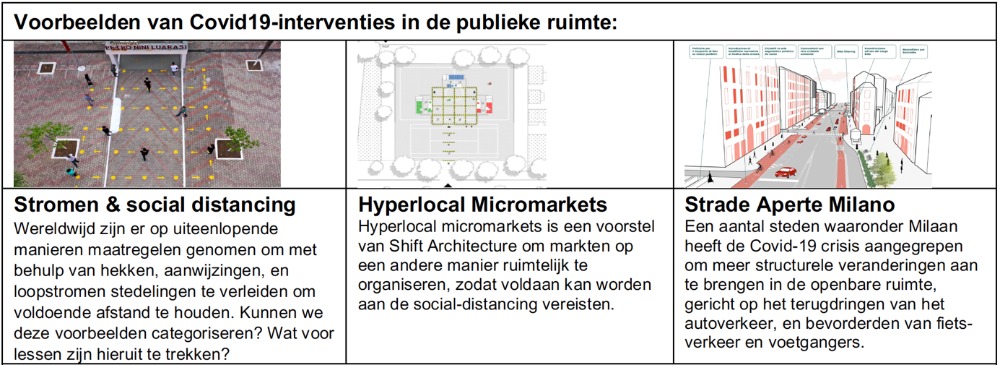
Voorbeelden van Covid-19 interventies in de publieke ruimte
Van resisting naar transforming?
Hoe kunnen die concrete interventies, investeringen en spontane ontwikkelingen die nu voor de resisting en adapting van de pandemie plaatsvinden ook de kiem leggen voor het vinden van oplossingen voor onze grotere sociale of ecologische problemen? Conceptueel: hoe kunnen interventies voor resisting en adapting meteen ook iets zeggen over concrete ontwerpoplossingen voor transforming? Natuurlijk kunnen we met ons project niet meteen al die grote problemen oplossen. Om het concreet te maken focussen we op het schaalniveau van de buurt en hanteren we een research through design-methodiek. Met ons onderzoek willen we niet voorschrijven hoe het moet, maar voorbeeldstellend en onderbouwd in beeld brengen hoe dat kan. Wat leren we van de Covid-19-interventies in de publieke ruimte om ook de veerkracht te versterken?
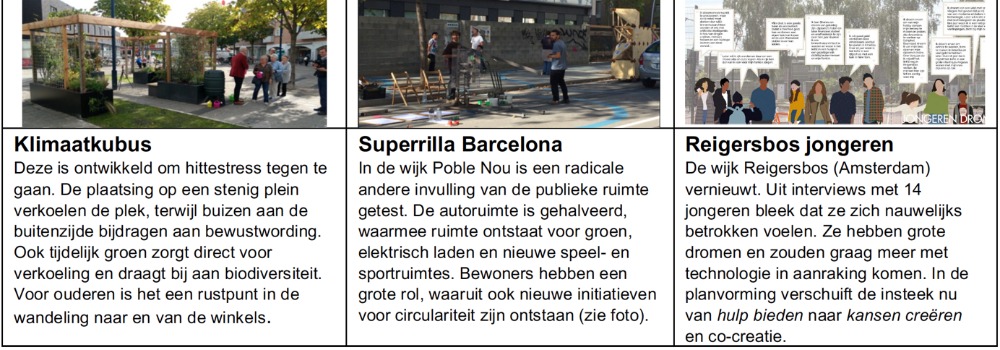
Voorbeelden van leerzame niet-Covid-gerelateerde interventies in de publieke ruimte
Dit is de data die we verzamelen:
- We brengen systematisch in kaart welke interventies in de openbare ruimte zijn ontwikkeld en toegepast ter preventie van Covid-19-besmettingen.
- We brengen met ons consortium in kaart welke (spontane) initiatieven op buurtniveau zijn ontstaan om de sociale effecten van Covid-19 te pareren.
- Daarnaast verzamelen we de verschillende typen concrete ingrepen die los van Covid-19 al bestaan om ook in sociaal-economisch kwetsbare buurten te werken aan klimaatverandering en leefbaarheid.
Deze data levert twee inzichten op. Het laat zien wat voor specifieke 'schade' Covid-19 heeft veroorzaakt, welke tekortkomingen aan het licht zijn gekomen en welke andere oplossingen dan gebruikelijk zich aandienden. Daarnaast levert de analyse van deze concrete sets interventies zicht op hun werkzame bestanddelen. Deze beschouwen we als de ‘bouwstenen’ en programma’s van mogelijkheden voor het research through design-deel van ons onderzoek. De ontwerp- en sociaalengineeringbureaus in ons consortium gaan met deze set ontwerpend onderzoekend verkennen hoe een nieuwe combinatie van deze bouwstenen tot ingrepen leiden die en preventief en transformatief zijn.
De coronacrisis hopen we daarmee niet alleen als een snel achter ons te laten situatie te beschouwen, maar ook als een natuurlijk experiment waarin nieuwe paden voor de toekomstige stad ontdekt kunnen worden. En hoe eerder we die in beeld kunnen brengen, hoe sneller we ook al gedurende de pandemie van onderop aan de structurele versterking van onze stad kunnen werken.
HvA-magazine Bewogen Stad: Leren in crisistijd
Bewogen Stad is een reeks van digitale tijdschriften over maatschappelijke kwesties in de Amsterdamse regio. Hier deelt Centre of Expertise Urban Governance en Social Innovation met een breder publiek waar HvA mee bezig is en biedt zij een plek voor verschillende geluiden uit het maatschappelijke debat. Lees het volledige magazine.
Stay up to date
Get notified about new updates, opportunities or events that match your interests.


